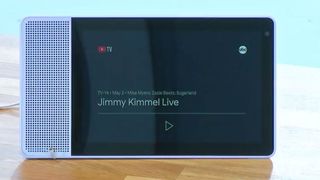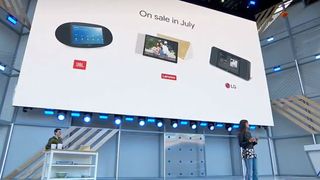Google’s Smart Displays to Connect with YouTube, YouTube TV

Taking a shot at video-capable smart home hubs from rivals such as Amazon, Google announced that a mix of CE partners are coming out with Smart Display products that work with Google Assistant and are integrated with YouTube and YouTube TV.
Those new products, from partners such as LG Electronics, JBL, and Lenovo, are slated to come out in July, Lilian Rincon, director of product management at Google, announced Tuesday at the Google I/O developer conference.

Those displays will support voice commands used for Google Home with the video components. A YouTube TV customer, for example, will be able to use Google’s new Smart Display to tune into a show and have it stream to the screen, or request a video from YouTube to be sent to the device.
Rincon also demonstrated how a Smart Display could also be used to show recipe information along with a video of step-by-step instructions on how the item is prepared.
Much of Google I/O was used to tout advancements in artificial intelligence, and how Google is applying the technology across multiple products.
Google, for example, has redesigned Gmail with A.I. to include a “smart compose” feature that uses machine learning to suggest phrases as the user writes. Users simply hit the Tab button to use the suggested auto-completing of sentences and phrases. That’s rolling out this month.
Google Assistant is using a technology called Wavenet that creates a more natural sounding voice, with respect to pitch, pace and pauses that can convey meaning, using the raw audio. Google Assistant is also adding six new voices to Google Assistant, including one based on the voice of singer John Legend.
Multichannel Newsletter
The smarter way to stay on top of the multichannel video marketplace. Sign up below.
Scott Huffman, VP of Google Assistant engineering, said more than 500 million devices, including about 5,000 connected home devices, are now equipped with Google Assistant.
Among new features coming out in the weeks to come is “Continued Conversation,” which allows some back-and-forth and follow-up requests from the user without having to say, “Hey, Google,” each time. The system is also being made to support multiple actions/requests.
Google also talked up Android P, the new version of its mobile OS. Among the new features is an adaptive battery technology that improves battery life by employing machine learning to understand which apps the user is likely to open in given times of the day. There’s also an auto-brightness feature that accounts not just for current lighting conditions but also the user’s personal preferences.
Google is launching the Android P beta today for the Pixel and seven other “flagship” Android devices.
